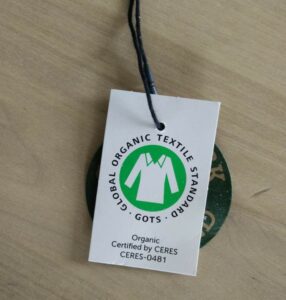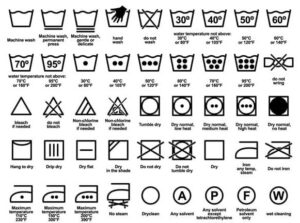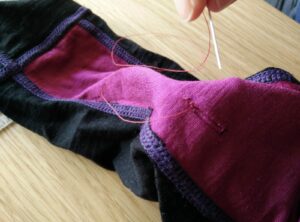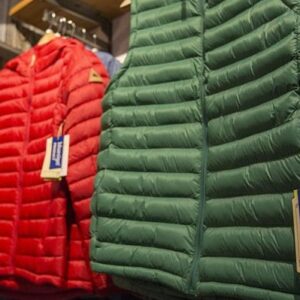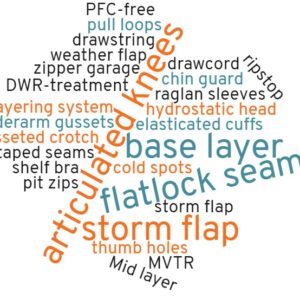
A kind reminder to hikers at Devil’s Millhopper Geological State Park by Michael Rivera
Most hikers are environmentally aware and follow the more or less (un)written rules when venturing out in nature, such as: “Leave nothing but footprints”, “take nothing but pictures” and “kill nothing but time”. As described in the article Sustainable Outdoor Clothing Materials? it can be hard to be equally eco-conscious when shopping apparel for your outdoor adventures as most clothing materials have one or more drawbacks in terms of sustainability. This article provides you with tips for making more sustainable choices when it comes to purchasing, repairing, caring for and disposing of your outdoor apparel. Some of the advice might seem like common sense, which you have been using for years, while other tips might come in handy and help both the environment while saving you some money as well.
Reducing the environmental footprint:
- Choosing the most sustainable option
- Making your outdoor clothing last longer I: Washing and drying
- Making your outdoor clothing last longer II: Repairing and mending
- Disposing of your outdoor clothing in a sustainable manner
Choosing the most sustainable option
The first thing to think about when you’re about to purchase some new hiking apparel, is whether you really need to buy it? Maybe you have something already which could be repaired and used again? Maybe you could borrow it from friends or family – especially if it is something you only plan to use once or rarely? Maybe you can even rent it from a physical outdoor shop? If you decide that purchasing is the only viable option, consider if you can buy it used or perhaps refurbished from the manufacturer. The outdoor retailer REI for example has a complete online section with only slightly used and thoroughly inspected outdoor apparel and gear, where you can make a good bargain. Online vendor CampSaver, on the other hand, has its Shed section with heavily discounted vendor samples, and refurbished or demo products. Whatever the condition of the garment (new, used, refurbished), you can make sure that it has the lowest possible environmental footprint by choosing something which is certified with one or more internationally recognized sustainability standards such as:
- bluesign for the entire production process of all types of textiles.
- Global Organic Textile Standard (GOTS) for all natural fabric materials (i.e. not synthetics).
- EU Ecolabel for all kinds of textile clothing and gear, as well as shoes and other products.
- Forest Stewardship Council (FSC) for wood-based textiles like bamboo, lyocell and Tencel.
- Leather Working Group (LWG) standard for leather, nubuck and suede
The most important thing when purchasing something new is, however, to make sure that it is high-quality and will serve you well for many years to come. Reading Nail the Trail’s side-by-side reviews of various categories within outdoor apparel might help you narrow down exactly what your needs are and thus exactly what you should be looking for. Consider that you might save money by for example buying a pricier high-quality jacket or backpack just once rather than having to re-purchase cheap products which can’t stand the wear and tear of your outdoor activities.
Making your outdoor clothing last longer I: Washing and drying
Once you have acquired your new hiking garment, it should of course be used as much as possible for as long as possible. The worst is if the item remains unused in your closet – if so, resell it or give it to someone who will use it. While in use, the most important thing is that you care for your outdoor clothing properly to make it last. That means following the washing and drying instructions for the garment to the dot – or treating it even gentler. Generally you will always prolong the lifespan of clothes if you avoid to tumble-dry it, and refrain from unnecessary chemicals like bleach and fabric softener (a less damaging natural alternative is vinegar). Especially shell layers with any kind of water-resistant treatment (e.g. DWR) or underwear with an anti-microbial finish (e.g. Polygiene) should never be washed with fabric softener.
Clothes marked suitable to wash at 40⁰C (104⁰F) will last longer if washed at 30⁰C (86⁰F) or colder (in the States the Warm setting is usually around 90-110⁰F, while the Cold setting is around 60-80⁰F). Be aware that front-loading washing machines not only use less water and energy than top-loading washing machines (most common in the States, Canada and Australia), but also handle clothes more gently and thus enable a longer life-span. Of course hand-washing will take even less of a toll on garments than machine-washing, but the clothes will need to drip-dry afterwards. When choosing how to wash and dry your clothing, consider that these acts account for as much as two thirds of the environmental footprint of the product. Therefore, choose both appliances and detergents with care.
Making your outdoor clothing last longer II: Repairing and mending
In spite of caring meticulously for your apparel, durability or performance issues are bound to occur at some point. We have already written articles about how to mend holes in Merino clothing and re-waterproof rainwear with DWR-spray, but many outdoor brands will also have published online guidance about how to repair their apparel and gear, or even host how-to workshops on repairing. Some issues will of course be covered by the particular brand’s warranty guarantee, but it can really pay off to sacrifice some time and/or money on repairing the garment on your own if the warranty doesn’t cover the concern. Online retailer REI has a wide variety of guides on how to repair everything from a broken zipper to tears in a down jacket.
Disposing of your outdoor clothing in a sustainable manner
There might be several reasons for you not using a garment any longer – maybe it doesn’t fit you right due to weight loss/gain; maybe you are no longer into the particular activity it is meant for (ice climbing, trail running etc.) or maybe it is torn, stained or damaged beyond salvaging. If the garment is still useable, consider reselling it or giving it away to friends or charity shops which might have good use of it. However, even if it is so worn out that you think that neither you nor any other human could repair and wear the garment again, it should not go in the trash just yet.
Brands like The North Face, H&M and its sub-brands Monki and &Other Stories have made it possible for people to hand in any textiles from any brand in any condition in order to either resell, reuse (as cleaning cloths etc.) or recycle (by for example turning textile fibers into insulation) them. Other manufacturers are more limited in what they will receive for recycling (and reward it!); Levi’s and Madewell will only accept denim, Intimissimi only lounge- and underwear, and Patagonia will only accept items from the brand itself. All manufacturers mentioned will usually give you some kind of discount voucher to use on a new(!) item from the. Another option is to drop your garments off in the nearest Helpsy (the largest clothing collector in the Northeast US) bin, which manages to reuse or recycle 95% of the collected textile products and shoes. You can also donate your used outdoor clothing and footwear to the nearest thrift/charity shop, but make sure that it has a recycling program for items which are not suitable for resale. You reduce your environmental footprint by avoiding that as little as possible of your used (outdoor) clothing ends up in a landfill!
